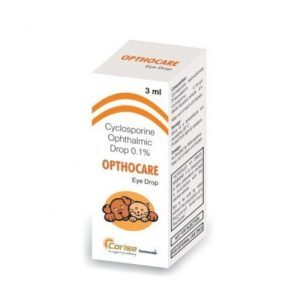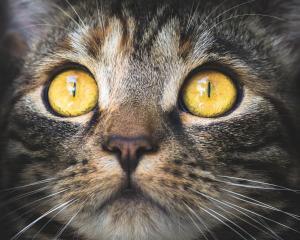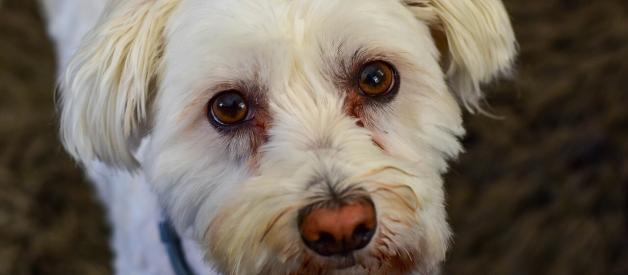Table of Contents
Opthocare eye drops consist of a 1% cyclosporine solution. This formulation effectively manages tear gland deterioration and restores the balance of the ocular surface’s natural functions. When used promptly in cases of KCS, these eye drops can lead to significant improvements. Cyclosporine’s mode of action revolves around inhibiting T-lymphocytes.

What Are Opthocare Eye Drops?
Opthocare eye drops feature cyclosporine, an immunosuppressant that effectively reduces the immune response within the lacrimal gland, thereby promoting the restoration of the aqueous layer production. Early intervention with cyclosporine yields remarkable improvements in Keratoconjunctivitis sicca (KCS) cases, and early detection of KCS contributes to preserving vision. The mechanism of action of cyclosporine primarily involves inhibiting T-lymphocytes.
Ingredients
In every milliliter of Opthocare eye drops, you will find:
- Cyclosporine Hydrochloride IP, which is equivalent to 0.1% w/v of cyclosporine;
- Benzalkonium Chloride IP at a concentration of 0.004% w/v;
- The remaining volume consists of a sterile aqueous vehicle.
Uses of Opthocare Eye Drops
Opthocare eye drops offer a versatile solution for various ocular concerns. This unique formulation is specifically indicated for:
- Preserving Tear Glands: Opthocare eye drops are invaluable in controlling the destruction of tear glands and restoring balance to the ocular surface’s natural functions.
- Enhancing Tear Production: They promote the natural production of tears while maintaining their viscosity, ensuring optimal eye moisture.
- Alleviating Inflammation: Opthocare eye drops reduce painful inflammation, safeguarding eyes from ophthalmic degradation.
- Keratoconjunctivitis Sicca (KCS): Early intervention with Cyclosporine in Opthocare eye drops leads to remarkable improvements in Keratoconjunctivitis sicca (KCS) cases, helping protect vision.
- Chronic Superficial Keratoconjunctivitis and Pannus: These eye drops are beneficial for managing chronic superficial keratoconjunctivitis and pannus, promoting better eye health.
- Immune-Mediated Keratoconjunctivitis Sicca: They are also effective in immune-mediated keratoconjunctivitis sicca, addressing this condition comprehensively.
Trust Opthocare eye drops for your pet’s eye care needs, offering a holistic approach to maintaining the health and comfort of eyes.
Dosage
|
Condition |
Dosage |
Administration |
|
KCS (Keratoconjunctivitis Secca) |
1 to 2 drops |
Twice a day |
|
VKC (Viral Keratoconjunctivitis) |
1 to 2 drops |
Twice a day or as directed by the veterinarian. |
Important Safety Information for Pet Owners
Opthocare eye drops are a valuable tool for maintaining your pet’s eye health, but using them safely and responsibly is essential. Here are some crucial safety guidelines to keep in mind:
- Administer as Directed: Always follow your veterinarian’s dosage and administration instructions. Do not exceed the recommended dose unless specifically advised by a veterinary professional.
- Avoid Contamination: Ensure that the dropper tip does not come into contact with your pet’s eye or other surfaces. Contamination can lead to infections or adverse reactions.
- Hand Hygiene: Wash your hands thoroughly before and after applying the eye drops to prevent cross-contamination.
- Monitor for Adverse Reactions: Keep a close eye on your pet after applying the eye drops. Contact your veterinarian promptly if you notice any signs of discomfort, irritation, redness, or unusual behavior.
- Storage: Store Opthocare eye drops in a cool, dry place, away from direct sunlight and out of the reach of children and pets. Follow the storage instructions on the product label.
- Use in Consultation with a Veterinarian: Opthocare eye drops should only be used under the guidance and prescription of a licensed veterinarian. Discuss concerns or questions about your pet’s eye health with a professional.
- Keep Out of Reach of Children: Opthocare eye drops are intended for veterinary use only. Ensure they are stored securely and are inaccessible to children.
- Do Not Self-Diagnose: Do not use Opthocare eye drops without diagnosing your pet’s eye condition. Self-diagnosis and treatment can lead to incorrect usage and potential harm.
- Allergies: If your pet has known allergies or sensitivities to any of the ingredients in Opthocare eye drops, inform your veterinarian immediately.
- Regular Check-ups: Continue with any recommended follow-up appointments with your veterinarian to assess your pet’s progress and adjust the treatment plan if necessary.
Remember that your veterinarian is your best source of information and guidance regarding your pet’s eye health. If you have any doubts or questions about using Opthocare eye drops, consult with them promptly. Your pet’s well-being is our top priority.
Veterinary Prescription
Opthocare eye drops typically require a veterinary prescription for purchase. These eye drops contain an active ingredient, and their use should be determined and supervised by a veterinarian who can diagnose the specific eye condition and prescribe the appropriate treatment. To obtain Opthocare eye drops, consult your veterinarian, who can assess your pet’s condition and provide the necessary prescription if deemed appropriate. Additionally, check with local regulations and the policies of the pharmacy or supplier you plan to use, as they may have specific requirements for purchasing prescription medications.
Interactions
There are no commonly reported drug interactions with Opthocare eye drops. However, it’s crucial to note that specific interactions can vary depending on the individual pet, their health condition, and any other medications they may be taking. To ensure the safety and effectiveness of Opthocare eye drops for your pet, it’s essential to follow these precautions:
- Provide a Medication List: Inform your veterinarian about any other medications, supplements, or treatments your pet receives. This information will help your veterinarian assess potential interactions.
- Follow the Veterinarian’s Instructions: Adhere to your veterinarian’s dosage and administration instructions. Do not adjust the dose or frequency without their guidance.
- Monitor for Side Effects: Keep a close eye on your pet after starting Opthocare eye drops. Contact your veterinarian immediately if you notice any unusual behavior, discomfort, or adverse reactions.
- Communicate Any Changes: If your pet’s health condition changes or if they are prescribed new medications while using Opthocare eye drops, inform your veterinarian promptly.
While Opthocare eye drops may have a low likelihood of systemic interactions, they are designed for topical use in the eyes. Always prioritize your pet’s well-being by seeking professional veterinary advice and supervision when using any medication.
Side Effects
Opthocare eye drops containing cyclosporine are generally considered safe when used as directed by a veterinarian. However, like any medication, they may cause side effects in some pets. Common side effects associated with Opthocare eye drops can include:
- Transient Stinging or Discomfort: Some pets may experience a brief stinging or discomfort upon application of the eye drops. This sensation typically subsides quickly.
- Eye Irritation: In rare cases, Opthocare eye drops may cause mild irritation or redness in the eye. If it persists or worsens, this side effect should be monitored and reported to your veterinarian.
- Tearing or Watery Eyes: Increased tearing or watery eyes can occur in some pets, especially during the initial stages of treatment. This is often a temporary side effect.
- Eye Allergic Reactions: Although uncommon, some pets may exhibit allergic reactions to the ingredients in Opthocare eye drops. Signs of an allergic reaction may include swelling, itching, redness, or hives around the eye area. If you suspect an allergic reaction, seek immediate veterinary attention.
- Systemic Side Effects: While the risk is low due to the topical application of the drops, there is a minimal chance of systemic side effects such as gastrointestinal upset or changes in appetite. These are less common but should be reported to your veterinarian if observed.
Most side effects associated with Opthocare eye drops are mild and temporary. Not all pets will experience these side effects, and many pets tolerate the medication well. If you notice any unusual or concerning symptoms in your pet while using Opthocare eye drops, contact your veterinarian promptly.

Overdose
Opthocare eye drops containing cyclosporine are designed for topical use in the eyes and are generally considered safe when used as directed by a veterinarian. However, an overdose of Opthocare eye drops can lead to increased side effects or adverse reactions. It’s essential to follow your veterinarian’s prescribed dosage and administration instructions carefully to minimize the risk of overdose.
If you suspect that your pet has received an overdose of Opthocare eye drops or has ingested the medication orally, you should take the following steps:
- Contact Your Veterinarian: Immediately contact your veterinarian or an emergency veterinary clinic. Provide them with detailed information about the situation, including the amount of medication ingested (if applicable) and your pet’s current condition.
- Observe Your Pet: While waiting for veterinary guidance, closely monitor your pet for any signs of unusual behavior, adverse reactions, or distress.
- Do Not Induce Vomiting: Do not attempt to induce vomiting or administer any other home remedies unless specifically instructed to do so by a veterinarian. The appropriate treatment for an overdose will depend on the specific circumstances and your pet’s condition.
- Seek Professional Care: Your veterinarian will assess your pet’s condition and provide appropriate treatment. This may include supportive care, monitoring, or interventions to address any potential side effects or complications.
It’s crucial to act quickly and seek veterinary assistance if an overdose is suspected. Timely intervention can help mitigate the effects of an overdose and ensure your pet’s well-being.
Storage
Store Opthocare eye drops in a cool, dry place. Avoid exposure to excessive heat or direct sunlight, as this can affect the stability of the medication. Always ensure the eye drop bottle cap is securely tightened after each use to prevent contamination and evaporation of the solution.
Store the eye drops in a location that is out of reach of pets and children. This prevents accidental ingestion and ensures their safety. Do not freeze Opthocare eye drops. Freezing can alter the composition of the solution and reduce its effectiveness.
Before each use, check the expiration date on the packaging. Do not use the eye drops if they have expired, as they may not be as effective or safe.
If your veterinarian provides specific storage instructions for the eye drops, adhere to those recommendations.
FAQ
What are Opthocare eye drops used for?
Opthocare eye drops are typically used to manage and treat eye conditions in pets, including keratoconjunctivitis sicca (KCS) or dry eye syndrome.
How should I administer Opthocare eye drops to my pet?
Administer the prescribed number of drops directly into your pet’s affected eye(s) as directed by your veterinarian. Be careful not to touch the dropper tip to the eye to prevent contamination.
Can Opthocare eye drops be used in different types of animals, such as cats and dogs?
Opthocare eye drops are generally safe for use in various species of animals, including cats and dogs, but the dosage and administration may vary. Follow your veterinarian’s guidance for your specific pet.
What should I do if my pet experiences an adverse reaction or side effect from Opthocare eye drops?
Contact your veterinarian immediately if you suspect an adverse reaction or side effect. They can guide whether to continue or discontinue the medication.
Can I use Opthocare eye drops on my pet if they take other medications or have underlying health conditions?
Inform your veterinarian of all medications your pet takes and any existing health conditions. Your veterinarian will consider potential interactions and guide the safe use of Opthocare eye drops.
Can Opthocare eye drops be used for preventive eye care in healthy pets?
Opthocare eye drops are typically prescribed for treating specific eye conditions and are not intended for routine preventive use. Consult your veterinarian for recommendations on preventive eye care.
What should I do if I miss a dose of Opthocare eye drops for my pet?
If you miss a dose, administer it as soon as you remember. However, if it’s close to the time for the next scheduled dose, skip the missed dose and continue with the regular dosing schedule. Do not double the dose to make up for a missed one without consulting your veterinarian.
Olivia Bennet is a veterinarian who has worked in a veterinary clinic for many years. She specializes in the diagnosis, disease prevention, and treatment of not only cute kittens and puppies but also large farm animals. Olivia loves animals, cares about them, and wants to help you know more about your pets.

































